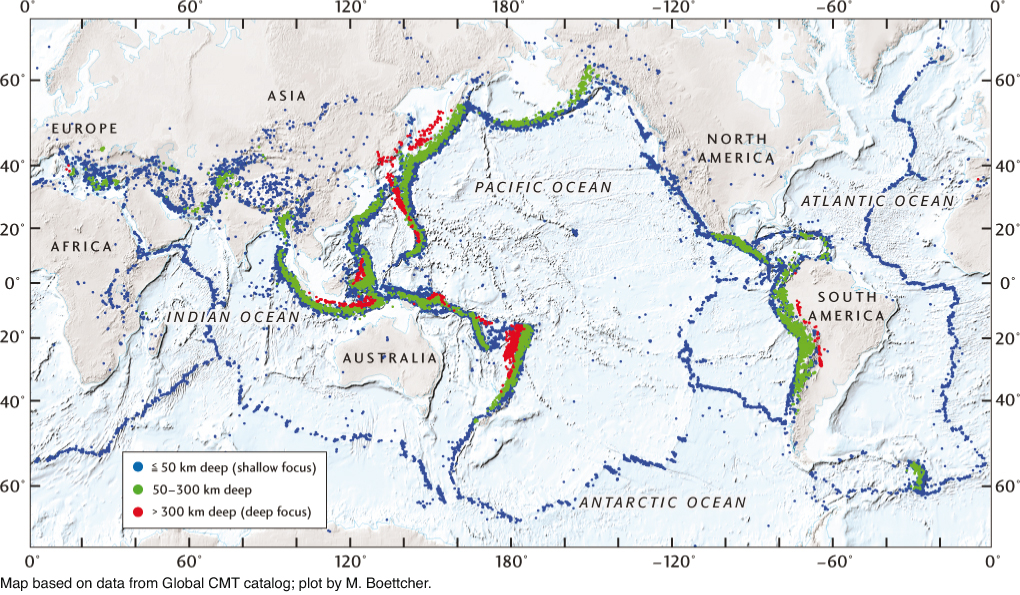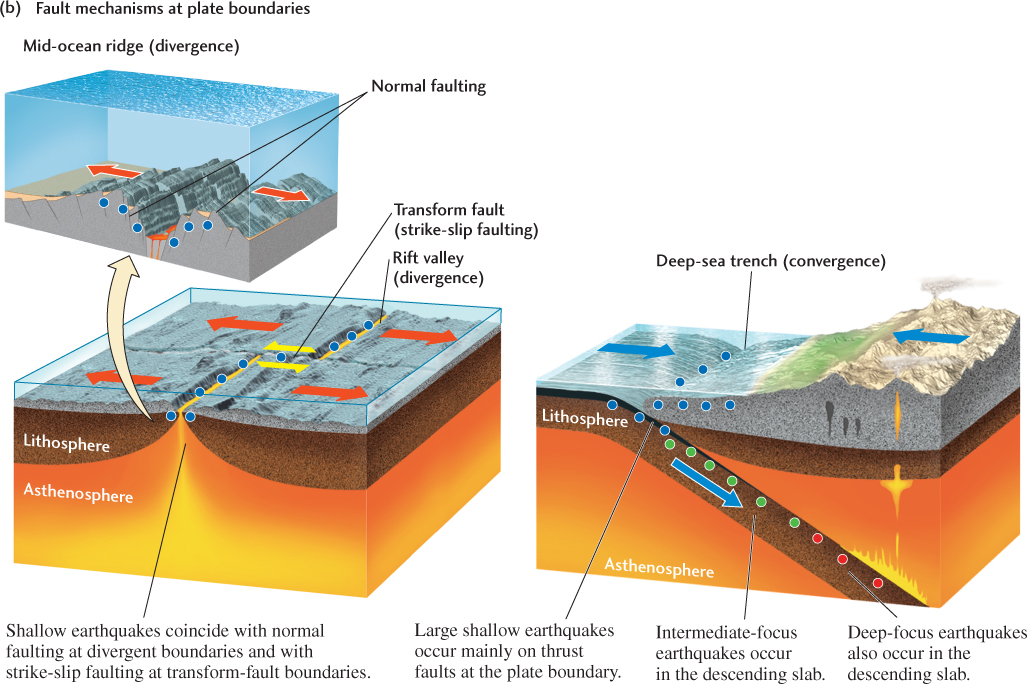Earthquakes and Patterns of Faulting
As we have seen, seismologists are using networks of sensitive seismographs to locate earthquakes around the world, measure their magnitudes, and deduce their fault mechanisms. These methods are revealing new information about tectonic processes on scales much smaller than the plates themselves. In this section, we summarize the global pattern of earthquake occurrence from the perspective of plate tectonics and show how regional studies of active fault systems are improving our understanding of earthquakes along plate boundaries and within plate interiors.
The Big Picture: Earthquakes and Plate Tectonics
The seismicity map in Figure 13.16 shows the epicenters of earthquakes recorded around the world since 1976. The most obvious features of this map, known to seismologists for many decades, are the belts of seismic activity that mark the major plate boundaries. The fault mechanisms observed for earthquakes in these belts (Figure 13.17) are consistent with the types of faulting along different types of plate boundaries that we described in Chapter 7.


363
364
Divergent Boundaries
The narrow belts of shallow earthquakes that run through ocean basins coincide with mid-ocean ridge crests and their offsets on transform faults. The P waves recorded from the ridge-crest quakes indicate that they are caused by normal faulting. The faults strike parallel to the ridge and dip toward the rift valley at the ridge crest. Normal faulting implies that tensional forces are at work as the plates are pulled apart during seafloor spreading. Earthquakes also have normal fault mechanisms in zones where continental crust is being pulled apart, such as in the East African rift valleys and in the Basin and Range province of western North America.
Transform-Fault Boundaries
Earthquake activity is even greater along the transform-fault boundaries that offset mid-ocean ridge segments. These earthquakes have strike-slip fault mechanisms, just as one would expect where plates create horizontal shearing forces as they slide past each other in opposite directions. Moreover, for earthquakes along these transform faults, the slip direction indicated by the fault mechanisms is left-lateral where the ridge crest steps right and right-lateral where it steps left. These directions are the opposite of what would be needed to create the offsets of the ridge crest, but are consistent with the direction of slip predicted by seafloor spreading. In the mid-1960s, seismologists used this property of the transform faults to support the hypothesis of seafloor spreading. Slip directions on transform faults that run through continental crust, such as California’s San Andreas fault and New Zealand’s Alpine fault (both right-lateral), also agree with the predictions of plate tectonics.
Convergent Boundaries
The world’s largest earthquakes occur at convergent plate boundaries. The four greatest earthquakes of the last hundred years were of this type: the 2011 Tohoku earthquake (magnitude 9.0); the Sumatra earthquake of 2004; the Alaska earthquake of 1964; and the largest of all, the 1960 earthquake in the subduction zone west of Chile. During the Chile earthquake, the crust of the Nazca Plate slipped an average of 20 m beneath the crust of the South American Plate on a fault rupture with an area larger than Arizona! The fault mechanisms of these great earthquakes show that they were caused by horizontal compression along megathrusts, the huge thrust faults that form the boundaries where one plate is subducted beneath another. All three of these earthquakes displaced the seafloor, generating tsunamis that devastated coastlines.
Earth’s deepest earthquakes also occur at convergent boundaries. Almost all earthquakes originating below 100 km rupture the descending plate in a subduction zone. The fault mechanisms of these deep earthquakes show a variety of orientations, but they are consistent with the deformation expected within the descending plate as gravity pulls it back into the convecting mantle. The deepest earthquakes take place in the oldest—and therefore coldest—descending plates, such as those beneath South America, Japan, and the island arcs of the western Pacific Ocean.